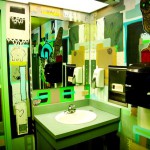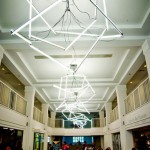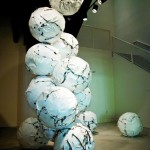- Glassy eyed: The Fire on the Mountain exhibit in the new East Wing features 50 years’ worth of glass work from Western North Carolina. Photo by Max Cooper
- The best seat in the house: Gabriel Shaffer and friends bring graffiti-inspired art into unlikely corners of the expanded Asheville Art Museum. Photo by Max Cooper
- Highlights: Hoss Haley’s fluorescent sculptures illuminate the bold innovations afoot (and aloft) at AAM. Photo by Max Cooper
- Spun cycle: Of his repurposed-washing-machines piece, Hoss Haley says, “They’re like paper you just ball up.” Photo by Max Cooper
Looking at the big move into the new space
On March 23, the Asheville Art Museum premiered Art Works PRIMED — the first phase of its Interim Expansion Project that takes it into the former Health Adventure space at Pack Place. (The Health Adventure relocated to the Biltmore Square Mall in October 2011.) Despite the utilitarian terms of the event, the public gala was colorful (body paint, masks and “creative white-tie” costumes); exciting (DJ Whitney Shroyer and performance art); and crowded. In other words, the opening was exactly what the museum hasn’t been in a while.
If PRIMED is in fact a primer, or a preview of what’s to come, then the museum is heading toward becoming a hub for local art. Much of the work currently on display in the PRIMED areas is that of Asheville and regional artists.
So what is PRIMED?
It’s a new wing, and a facelift for Pack Place’s promenade.
The carpet has been torn out. Gone are the butterflies that used to hang from the ceiling. A number of interior window panes that previously separated the hallway from the museum gift shop have been either removed or filled in to create extra gallery space. And the gift shop itself has been gutted and moved across the hall to where the various scale-models of the city were displayed.
No more is the sedative gray-blue atmosphere. New lights now adorn the whitewashed walls. A series of ceramic tiles by Weaverville artist Kathy Triplett have new prominence. The tiles have been there for years, but only now seem to come into visibility.
Around the corner are the revamped bathrooms and the official entrance to the museum’s two-floor East Wing, which includes an exhibition gallery, the Artworks Project Space, a New Media Gallery, a multipurpose “flex” space and an interactive children's facility called ArtPLAYce. The museum has expanded nearly 24,000 square feet in all, bringing the total domain to approximately 53,000 square feet, including about 7,000 square feet of gallery space.
Much of the new space, formerly occupied by the Health Adventure, was completely stripped to the bare essentials: walls.
Aside from the direct reference to new beginnings and a primed canvas, PRIMED’s thematic approach is that of “deconstruction.” But deconstruction, as an aesthetic, comes off as unfinished rather than intentional. The lights have exposed bases, the wiring hanging out. A few disheveled ceiling tiles and Pack Place’s visitor information desk have been wrapped in cloth tied up with ropes and clamps. The concrete floors are currently unfinished, but it works well for the space. Drop ceilings remain in the former Health Adventure branch.
The museum’s permanent collection focuses on interpreting American artwork, from the start of the 20th century through today, and the future expansion will include more permanent collection galleries. Currently, the museum 's collection includes 3,572 works of varying media, such as paintings, sculptures and other 3-D works, prints, drawings and photographs. Due to spatial and conditional limitations — temperature control, excessive natural light and other art-threatening elements — roughly 3 percent of those works can be displayed at one time. The museum plans to refurbish some of its gallery space to accommodate more of its collection. The collection also includes 4,905 architectural drawings.
A permanent home
The Asheville Art Museum’s history of relocating and renovating began with its 1948 inception on the north end of Charlotte Street, followed by temporary residences at the 15th floor of the Northwest Bank (now the BB&T building), a Montford home and the Civic Center basement. In 1992, the museum opened in the newly minted Pack Place Education, Arts and Science Center, which includes the 1925 Italian Renaissance-style building that housed the Pack Library until 1979, and where the museum remains today.
Art Works PRIMED is a step on the way to a larger capital-improvement project that the museum has dubbed Art Works for Asheville. The museum has raised about $7.5 million toward its fundraising goal of $24 million for the total overhaul, says Executive Director Pam Myers. Eighteen to 24 months of fundraising and design tweaking lay ahead.
The current entrance to Pack Place will be stripped down to its steel frame and rebuilt with a modern glass facade designed by New York-based Ennead Architects. Ennead, the sole architectural firm involved in the project since planning began in 2003, was selected by a panel of area architects, designers and artists. Asheville contracting outfit Beverly-Grant will do the construction, which is tentatively set to begin in 2014.
The project also includes restorations to the North Wing (the former Pack Library building), the addition of a gardened rooftop terrace and a cafe.
Graffiti in the bathrooms?
Even the bathrooms got a makeover. Asheville artist Gabriel Shaffer, with help from Joti Marra, Andy Herod, Chris King, Dustin Hinson, Juniper Cooper and retired graffiti writers (no names, of course) transformed the space with “The Writing on the Pharaoh’s Wall,” a graffiti/street art mural.
Myers saw a need to include graffiti and street art into the new space. It has an obvious presence in Asheville. It’s also showing up in prominent museum spaces — such as 2009’s Art in the Streets at the Museum of Contemporary Art in Los Angeles.
The inside and outside of the restroom space are covered in layers of color swatches and abstracted script, resembling the painted, covered and re-painted walls visible throughout the city (to the dismay of some business owners whose buildings host the unsolicited works). The work comes from Shaffer’s early exposure to graffiti and the Gee’s Bend quilts, he says. (Those patchwork quilts, created by a small enclave of Alabama women, are heralded as one of the crown jewels of Outsider Art).
As for his work being seen in the bathroom, Shaffer sees that as a plus.
“Lots of bodies from all different walks of life move through there,” he says. “It’s a space that everyone has to interact with.”
Shaffer is combining styles he’s seen in music-club bathrooms, such as New York’s now closed CBGB, with Asheville imagery. On the outside of the doors, there’s an Egyptian pharaoh meets Art-Deco version of the Thomas Wolfe angel sculpture outside the museum. You can see LaZoom’s Sister Bad Habit and Ami Worthen from uke-abilly outfit the Mad Tea, among others.
New additions, new media
This addition marks the most progressive, and perhaps most needed step in a direction the museum has only dabbled in: the digital realm.
The space was originally going to hold a more “traditional” gallery, with the requisite white walls and track lighting. But the present iteration is “a much better use of our non-money,” says Nancy Sokolove, the adult programs director and de facto curator for the New Media Gallery. Myers and Sokolove are excited about this space. The walls and ceiling were painted black, a projection booth was built in the back and a sound system was built.
For now, the New Media Gallery is restricted to video works. Boone-based artist Mark Nystrom uses live recordings of weather data gathered from rooftops, including AAM’s, that run computer programs that generate digital images. One such video is part of a rotating schedule of works from 10 North Carolina artists for Prime Time: New Media Juried Exhibition.
Other works range from Martha Skinner’s high speed NYC snapshot compilation taken from a biker’s point of view, to UNCA student Logan Kelly’s black-and-white stop-motion music video of a solo pianist locked in a newspaper-wallpapered bedroom.
To date, there is a noticeable absence of new media works in the AAM’s permanent collection, so the New Media Gallery fills a long-missing piece in the museum’s permanent collection. “This marks the beginning of the digital collection,” Myers says.
Lighting up the new space
Despite the white-walled and de-carpeted transformation of the museum’s promenade, it’s the lights that immediately grab your attention when you walk in the front door.
Asheville artist Hoss Haley, the creator of the five light sculptures, says they were made with 2,000 feet of wire and around 80 elongated fluorescent light bulbs. They appear in suspension, as if jettisoned from the ceiling but frozen in the moment — with a slight spider-web feel.
To keep with the “deconstructed” atmosphere (and, to reduce the need for rewiring and its associated costs), Haley used the footprints from the previous lights. The bases, uncovered and all-too-visible, deflect attention from the sculptures. A mesh of multicolored wires and electrical gadgetry protrude from their rectangular bases, giving the work an unfinished appearance.
Start of a new Cycle
Hoss Haley triumphs in the East Wing’s Artworks Project Space, a carved out enclave tucked into the stairwell. The space is designated as a host for site-specific art works. Haley takes the inaugural slot with “Cycle,” an outstanding work that will certainly be hard to follow.
The plights of appliance repair are at hand in this work. “These days it costs more to fix a washing machine than it does to buy a new one,” Haley says. The artist, who’s been getting his sculptural materials from the scrapyard for more than 30 years, began seeing the appliances trashed en masse. These days, washing machines have an average life span of five years, Haley says.
“They’re like paper that you just ball up and throw away,” Haley explained.
He started collecting them, stripping away the white enameled side panels and balling them up with the help of a hydraulic press. Over 20 machines make up the dozen or so balls, which stand 2 feet high and weigh in at 35 pounds apiece. They’re stacked in the space as if contained by a 12-foot-high invisible waste basket. Beside the stack are a few outliers, missed tosses, perhaps.








Before you comment
The comments section is here to provide a platform for civil dialogue on the issues we face together as a local community. Xpress is committed to offering this platform for all voices, but when the tone of the discussion gets nasty or strays off topic, we believe many people choose not to participate. Xpress editors are determined to moderate comments to ensure a constructive interchange is maintained. All comments judged not to be in keeping with the spirit of civil discourse will be removed and repeat violators will be banned. See here for our terms of service. Thank you for being part of this effort to promote respectful discussion.